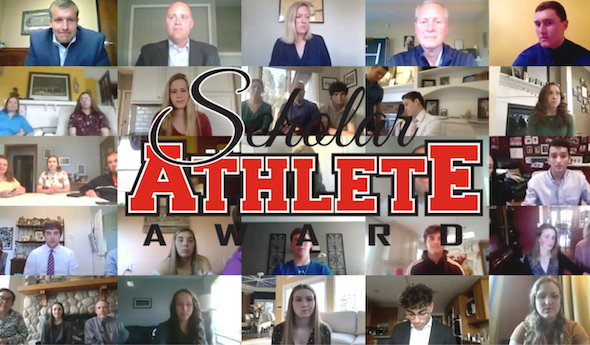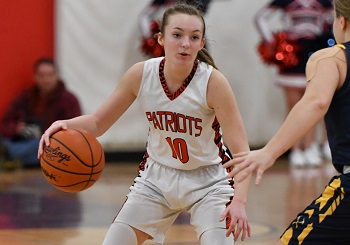
2020 Class Honored Together, from Afar
By
Geoff Kimmerly
MHSAA.com senior editor
May 15, 2020
Ishpeming Westwood’s girls basketball team was two hours into a three-hour trip to its Division 3 Regional Final on March 12 when the Patriots were told to turn the bus around and come home.
In an instant, the 2019-20 school year – and with it all MHSAA sports across the state – had come to a halt. And two months later, the high school world and its sports community continue to wait for bits of normalcy to return.
On Wednesday, we were able to enjoy a little bit of normal that’s been part of the annual MHSAA calendar for three decades. A Zoom call brought together 31 families from all over the state along with MHSAA staff and Farm Bureau Insurance CEO Don Simon to celebrate this year’s MHSAA/Farm Bureau Insurance Scholar-Athlete Award winners.
Living rooms, kitchens and home offices replaced Breslin Center as settings for this “virtual” ceremony. And yet, this ceremony may be remembered more than any other because of its necessity – due to the COVID-19 pandemic – and because of how it brought so many together, remotely, while the coronavirus has forced all of us to remain apart.
Below is the ceremony, in full, including words from Simon, MHSAA Executive Director Mark Uyl and Assistant Director Andy Frushour and, for the first time, a student speaker from the class – Ishpeming Westwood senior Madelyn Koski, who was part of that basketball team destined for Sault Ste. Marie. A brief Q&A with Koski follows.
Koski was an all-stater on the court who would’ve finished her high school career with four varsity letters each for hoops, tennis and softball. She will continue at Ferris State University, where she’ll pursue a degree in pharmacy and continue her basketball career.
Second Half: How did you decide what you wanted to say? Was there a message you wanted to get across?
It was easy to write the sad part, because I know what happened – I was there. But it was hard for me to make a positive spin at the end because I don’t think anyone’s over it yet. I was glad to be able to turn it into something that was bigger than sports … more about our whole lives and less about our time in high school.
Second Half: It’s been two months. How have you been navigating the disappointment, the sadness? And is there advice you’d give to other people your age trying to do it?
As time went on, it got a little bit better. The day after was pretty sad; that’s all I could think about. Now there’s so many other things to do – the weather’s nicer, we can go outside. And I’m playing college basketball – not everyone has that chance – but at least I have that to practice for, look forward to.
I guess, it’s just … time heals.
Second Half: Even though you can’t be with them and hang out with them, I’m sure you’re talking a lot of your friends and teammates. What kind of conversations are you having? Is it looking ahead? Is it still thinking about, “We’d be playing softball right now?"
I think we kinda tried to leave the basketball stuff in the past because it was too sad to talk about. We made sure we do talk, obviously not in person, but on social media or FaceTime, we just talk about our memories and everything. That helped. It didn’t close the chapter, but it was nice to talk to them when we were all alone. And now we just don’t talk about that anymore. Nobody really wants to talk about it. We see memories popping up on Facebook and all these other things about, “Oh, we had a softball game last year at this time.” And it’s pretty sad. But no one else is playing. So it’s like we’re all in the same boat.
 Second Half: You can turn on the news and you can see what every adult has to say about what’s going on right now. … You’re 17, you’re finishing your last year of high school, you’re going through something no one has gone through in more than 100 years. How do you see everything that’s happening in the world right now, as you look at it from a 17-year-old’s point of view and see seasons end and school end?
Second Half: You can turn on the news and you can see what every adult has to say about what’s going on right now. … You’re 17, you’re finishing your last year of high school, you’re going through something no one has gone through in more than 100 years. How do you see everything that’s happening in the world right now, as you look at it from a 17-year-old’s point of view and see seasons end and school end?
I know we can’t help what happened. But obviously I think it’s unfair that it happened to our class. It stinks for every grade, but (as seniors) we’re missing out on our best parts of high school right now and it’s pretty horrible. We’ve been waiting years for our senior proms and graduations, banquets and award ceremonies, like the MHSAA one. So that kinda stinks.
Ever since March 12, I’ve been staying optimistic. But I’m proved wrong every time because things just keep getting canceled and canceled. … (But) I’m a pretty optimistic person, so I still have some left.
Second Half: What happens next? What does your summer look like? What happens for people who are in your shoes?
I’ll keep working out, and one of the girls on my high school basketball team is going to play at Michigan Tech so (eventually) we can work out together. … I think the biggest thing to do this summer, that I think I’ll do, is appreciate time with my family. I have gotten to spend a lot of time with them. And then maybe once summer rolls around and we’re allowed to be in bigger groups, I’ll be able to be with people other than my mom and dad, like my grandparents and cousins and my aunts and uncles. … (My sister Jillian and I) have been playing the same varsity sports for the last couple of years, and she’s been really successful. It’s been fun to win all these championships and stuff with her.
Second Half: What do you think you’re going to remember from this in five years, 10 years, when people ask you what your experience was like?
I’m probably going to say it’s a pretty bad experience. I guess it was an eye-opener that life can change at any moment. That’s kind’ve it. It didn’t change in a good way.
PHOTO: Westwood's Madelyn Koski sets up a play as Negaunee's Breanne Giotto defends her during their Jan. 24 game. (Photo by Cara Kamps.)

MHSAA Schools' National Participation Ranking Rises, Continues to Outpace Population
By
Geoff Kimmerly
MHSAA.com senior editor
September 12, 2024
Michigan’s national ranking for participation in high school athletics improved during the 2023-24 school year, overall and also for girls and boys sports separately, and while continuing to outpace its national ranking for high school-aged population, according to the annual national participation study conducted by the National Federation of State High School Associations (NFHS).
Michigan moved back into eighth for overall participation nationally, based on a total of 289,740 participants, after ranking ninth in 2022-23. The total counts students once for each sport played, meaning students who are multiple-sport athletes are counted more than once.
Michigan improved to seventh nationally for boys (169,533) and eighth for girls (120,207) participation separately, after ranking ninth for both the previous year and despite currently ranking 10th for both high school-aged boys and girls populations according to U.S. Census Bureau estimates.
Michigan’s national rankings in eight sports for which the MHSAA sponsors postseason tournaments improved from 2022-23, with only four sports moving down on their respective lists from the previous year.
Notably, Michigan led the nation in participation in a sport for the first time in at least 14 years – boys bowling with 4,292 athletes – and also moved up to third nationally for girls bowling, girls golf and girls tennis participation. Boys golf (fourth), wrestling (seventh – girls and boys combined), girls competitive cheer (eighth) and boys lacrosse (nine) also moved up on their respective lists.
Keeping with annual trends, participation in several more MHSAA sports also continued to outpace the state’s rankings for high school-aged population.
For girls, participation in volleyball (fifth), cross country (sixth), basketball (seventh), softball (seventh), swimming & diving (eighth), track & field (eighth) and soccer (ninth) all ranked higher than their population listing of 10th nationally. Among boys sports, ice hockey (fourth), tennis (fifth), track & field (sixth), basketball (seventh), cross country (seventh), football (seventh – 11 and 8-player combined), baseball (eighth), swimming & diving (eighth) and soccer (ninth) exceeded the boys ranking of 10th for population.
Only 11 states sponsor alpine skiing, but Michigan again ranked third on both the girls and boys lists for that sport. For wrestling, boys participation moved down one spot to eighth but girls participation moved up one spot to seventh – and their totals combined ranked seventh nationally overall, also up one spot from 2022-23.
Participation nationally exceeded 8,000,000 participants for the first time, with a total of 8,062,302 an increase of 2.7 percent from 2022-23. The total includes 4,638,785 boys and 3,423,517 girls – both record highs – according to figures obtained from the 51 NFHS member state associations, which includes the District of Columbia.
Eleven-player football remained the most popular boys sport and registered an increase for the second consecutive year from 1,028,761 to 1,031,508 athletes. There also was an increase in 8-player football participation from 23,812 to 26,420.
Next on the boys list were outdoor track & field, basketball, baseball, soccer, wrestling, cross country, tennis, golf, and swimming & diving, respectively.
For girls, outdoor track & field, volleyball and soccer all registered increases and remained the top three participatory sports. Track & field increased four percent to 506,015, followed by volleyball at 479,125 and soccer with 383,895 participants. Basketball ranked fourth, followed by softball, tennis, cross country, competitive spirit, swimming & diving and lacrosse, respectively.
Texas (859,301) and California (834,103) remained atop the list of state participation. New York (341,454) remained in third, followed by Pennsylvania (336,946), Ohio (323,117), Illinois (320,603), Florida (299,398), Michigan (289,740), New Jersey (280,798) and Minnesota (224,179).
The NFHS participation survey was started in 1971 and compiled in its current form through the 2018-19 school year, resuming annually with the 2021-22 survey.
The NFHS, based in Indianapolis, is the national leadership organization for high school sports and performing arts activities. Since 1920, the NFHS has led the development of education-based interscholastic sports and performing arts activities that help students succeed in their lives. The NFHS writes playing rules for 17 sports for boys and girls at the high school level. Through its 50 member state associations and the District of Columbia, the NFHS reaches more than 19,800 high schools and 12 million participants in high school activity programs, including more than eight million in high school sports.
The MHSAA is a private, not-for-profit corporation of voluntary membership by more than 1,500 public and private senior high schools and junior high/middle schools which exists to develop common rules for athletic eligibility and competition. No government funds or tax dollars support the MHSAA, which was the first such association nationally to not accept membership dues or tournament entry fees from schools. Member schools which enforce these rules are permitted to participate in MHSAA tournaments, which attract more than 1.4 million spectators each year.

